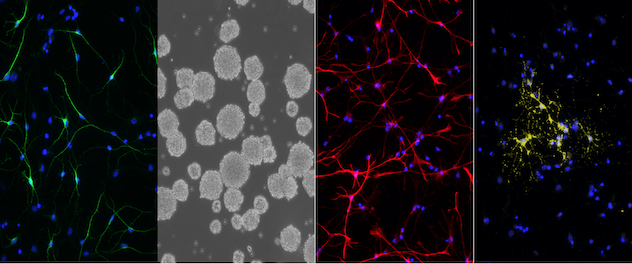-

Glial control of neural health, plasticity, and regeneration
Glial cells, including astrocytes (red) and oligodendrocytes (green), play essential roles in regulating brain physiology, its response to injury and capacity for regeneration. Dr. Scarisbrick's lab studies how glial metabolic activities are altered in central nervous system (CNS) injury and disease and how this can be modulated to improve the capacity for regeneration and restoration of function.
-

Neural stem cells offer new hope for cell replacement and restoration of function
The lab's team is developing sources of multipotent neural stem cells that can be differentiated into neurons, neurospheres, astrocytes and oligodendrocytes to rebuild neural circuitry in the injured and diseased central nervous system.
-

Teamwork is key
Dr. Scarisbrick's multidisciplinary team uses knowledge gained from their research to develop new pharmacological, cellular, and rehabilitation interventions. By improving neuron and glial metabolic function, the lab hopes to promote neural plasticity, regenerative repair and restoration of function.
Overview
The mission of Dr. Scarisbrick's Neuroregeneration and Neurorehabilitation Laboratory is to improve functional outcomes in individuals with neurological injury or disease. The lab seeks to uncover fundamental biological mechanisms applicable to a wide range of neurological conditions with a unique focus on spinal cord injury and demyelinating conditions such as multiple sclerosis.
The lab's research focuses on promoting plasticity and regeneration in the injured and diseased central nervous system. By focusing on the discovery of fundamental mechanisms that govern the biology and physiology of the developing and adult nervous system, and how these processes are altered in the context of injury and disease, the lab seeks to identify new therapeutic interventions relevant to a wide range of diseases.
Using clinical samples and genetic models focused on congenital, traumatic and neuroinflammatory conditions, the lab has already identified several targets for therapeutic intervention that promote improvements in function. These discoveries have resulted in multiple issued patents that are ready for licensing and continued development toward clinical translation.
A talented research team, composed of experts in biochemistry, molecular and stem cell biology, neuropathology, and rehabilitation, is spearheading these discoveries. The goal of the lab's team is to discover and translate new therapies to restore form and function for individuals with spinal cord injuries, demyelinating conditions and other debilitating disorders of the CNS for which current effective interventions are not available.
The lab's research team is composed of experts in neuropathology, biochemistry, molecular and stem cell biology, and rehabilitation, who:
- Understand biological mechanisms of neural injury and how these can be targeted therapeutically to foster repair.
- Discover new targets to promote neural regeneration and recovery of function in individuals with neurological injury and disease.
- Identify new ways to tap into the innate regenerative capacity of the brain and spinal cord.
- Bring together the latest expertise and technologies to understand regenerative mechanisms.
- Translate new discoveries into rationally designed therapies for patients.
- Train the next generation of neurobiologists to expedite discovery of new targets for neural repair, neural regeneration and neurorehabilitation to improve patient functional outcomes.
Focus areas
The lab's research is focused on translational discovery science to identify new targets for therapies that can promote regeneration in the central nervous system and restoration of function. The main research projects include:
- Spinal cord regeneration.
- Myelin regeneration.
- CNS metabolism and lipid physiology.
- Neural stem cells for CNS regeneration.
Affiliations